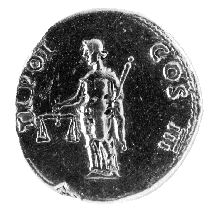



(82) Vespasian - AV aureus, A.D. 71, 7.22 g. (inv. 91.147).
Obverse: Laureate head of Vespasian r.; IMP(ERATOR) CAESAR VESPASIANVS AVG(VSTVS):
Imperator Caesar Vespasianus Augustus.
Reverse: Aequitas standing l., with scale in r. and rod in l.; TR(IBVNICIA)
POT(ESTATE) CO(N)S(VL) III: with tribunician power, consul for the
third time.
Provenance: Coin Galleries, 1959.
Bibliography: H. Mattingly and E.A. Sydenham, The Roman Imperial Coinage
II: Vespasian to
Hadrian (London 1926) 12.
The emperor Vespasian (Titus Flavius Vespasianus) had a successful military
career under Claudius and Nero. He was the last of four men acclaimed emperor
in the troubled year A.D. 68-69, and with his sons, Titus and Domitian,
he founded a new dynasty, the Flavians. Because he came into power following
a period of unrest and because he intended some necessary and unpopular
reforms, Vespasian was careful to dissociate himself from his discredited
predecessors and to undertake works for the benefit of the Roman public.
He continued the reconstruction of part of the city that burned in the fire
of A.D. 64, he began the Flavian Amphitheater (later known as the Colosseum)
as an arena for public entertainment on land reclaimed from Nero's extravagant
estate, and he completed the Temple of Divine Claudius, which Nero had failed
to finish, as a way of dissociating himself from Nero while paying homage
to the rest of the Julio-Claudians.
Vespasian's portraits, like those of Galba and Vitellius, break with the
Julio-Claudian tradition and return to a harsh realism reminiscent of the
veristic portraits of the late republic (see no. 60), no doubt as a further
means of dissociating himself from Nero. Vespasian was sixty when he became
emperor, and in his portraits he looks his age, heavy-set and bald, with
a broad, deeply lined forehead, deep creases around his eyes and mouth,
and lines ringing his neck. His tight-lipped mouth, hooked nose, and protruding
chin give him a tough look.
The reverse of his coin depicts Aequitas, the personification of equity
or fairness, particularly in business transactions. Here she appears with
her usual attributes, the scales and measuring rod that ensure fair transactions.
Her appearance on the coins of Vespasian at this time probably refers to
the fair administration of grain distribution.
C.L.L.



All contents copyright (c) 1996.
Lawrence University
All rights reserved.